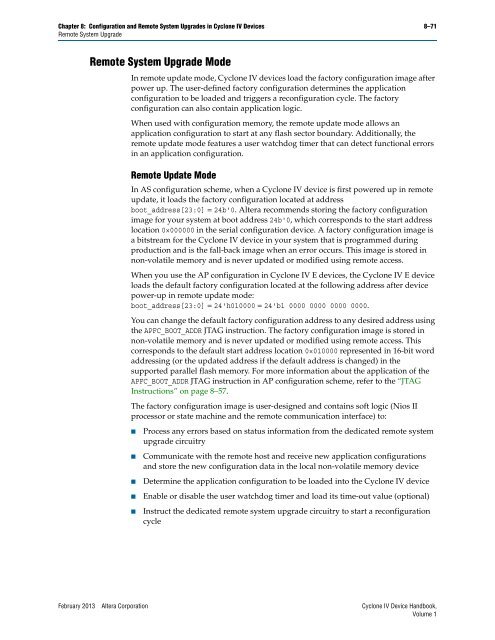Configuration and Remote System Upgrades in Cyclone IV ... - Altera
Configuration and Remote System Upgrades in Cyclone IV ... - Altera
Configuration and Remote System Upgrades in Cyclone IV ... - Altera
You also want an ePaper? Increase the reach of your titles
YUMPU automatically turns print PDFs into web optimized ePapers that Google loves.
Chapter 8: <strong>Configuration</strong> <strong>and</strong> <strong>Remote</strong> <strong>System</strong> <strong>Upgrades</strong> <strong>in</strong> <strong>Cyclone</strong> <strong>IV</strong> Devices 8–71<br />
<strong>Remote</strong> <strong>System</strong> Upgrade<br />
<strong>Remote</strong> <strong>System</strong> Upgrade Mode<br />
In remote update mode, <strong>Cyclone</strong> <strong>IV</strong> devices load the factory configuration image after<br />
power up. The user-def<strong>in</strong>ed factory configuration determ<strong>in</strong>es the application<br />
configuration to be loaded <strong>and</strong> triggers a reconfiguration cycle. The factory<br />
configuration can also conta<strong>in</strong> application logic.<br />
When used with configuration memory, the remote update mode allows an<br />
application configuration to start at any flash sector boundary. Additionally, the<br />
remote update mode features a user watchdog timer that can detect functional errors<br />
<strong>in</strong> an application configuration.<br />
<strong>Remote</strong> Update Mode<br />
In AS configuration scheme, when a <strong>Cyclone</strong> <strong>IV</strong> device is first powered up <strong>in</strong> remote<br />
update, it loads the factory configuration located at address<br />
boot_address[23:0] = 24b'0. <strong>Altera</strong> recommends stor<strong>in</strong>g the factory configuration<br />
image for your system at boot address 24b'0, which corresponds to the start address<br />
location 0×000000 <strong>in</strong> the serial configuration device. A factory configuration image is<br />
a bitstream for the <strong>Cyclone</strong> <strong>IV</strong> device <strong>in</strong> your system that is programmed dur<strong>in</strong>g<br />
production <strong>and</strong> is the fall-back image when an error occurs. This image is stored <strong>in</strong><br />
non-volatile memory <strong>and</strong> is never updated or modified us<strong>in</strong>g remote access.<br />
When you use the AP configuration <strong>in</strong> <strong>Cyclone</strong> <strong>IV</strong> E devices, the <strong>Cyclone</strong> <strong>IV</strong> E device<br />
loads the default factory configuration located at the follow<strong>in</strong>g address after device<br />
power-up <strong>in</strong> remote update mode:<br />
boot_address[23:0] = 24'h010000 = 24'b1 0000 0000 0000 0000.<br />
You can change the default factory configuration address to any desired address us<strong>in</strong>g<br />
the APFC_BOOT_ADDR JTAG <strong>in</strong>struction. The factory configuration image is stored <strong>in</strong><br />
non-volatile memory <strong>and</strong> is never updated or modified us<strong>in</strong>g remote access. This<br />
corresponds to the default start address location 0×010000 represented <strong>in</strong> 16-bit word<br />
address<strong>in</strong>g (or the updated address if the default address is changed) <strong>in</strong> the<br />
supported parallel flash memory. For more <strong>in</strong>formation about the application of the<br />
APFC_BOOT_ADDR JTAG <strong>in</strong>struction <strong>in</strong> AP configuration scheme, refer to the “JTAG<br />
Instructions” on page 8–57.<br />
The factory configuration image is user-designed <strong>and</strong> conta<strong>in</strong>s soft logic (Nios II<br />
processor or state mach<strong>in</strong>e <strong>and</strong> the remote communication <strong>in</strong>terface) to:<br />
■ Process any errors based on status <strong>in</strong>formation from the dedicated remote system<br />
upgrade circuitry<br />
■ Communicate with the remote host <strong>and</strong> receive new application configurations<br />
<strong>and</strong> store the new configuration data <strong>in</strong> the local non-volatile memory device<br />
■ Determ<strong>in</strong>e the application configuration to be loaded <strong>in</strong>to the <strong>Cyclone</strong> <strong>IV</strong> device<br />
■ Enable or disable the user watchdog timer <strong>and</strong> load its time-out value (optional)<br />
■ Instruct the dedicated remote system upgrade circuitry to start a reconfiguration<br />
cycle<br />
February 2013 <strong>Altera</strong> Corporation <strong>Cyclone</strong> <strong>IV</strong> Device H<strong>and</strong>book,<br />
Volume 1
















